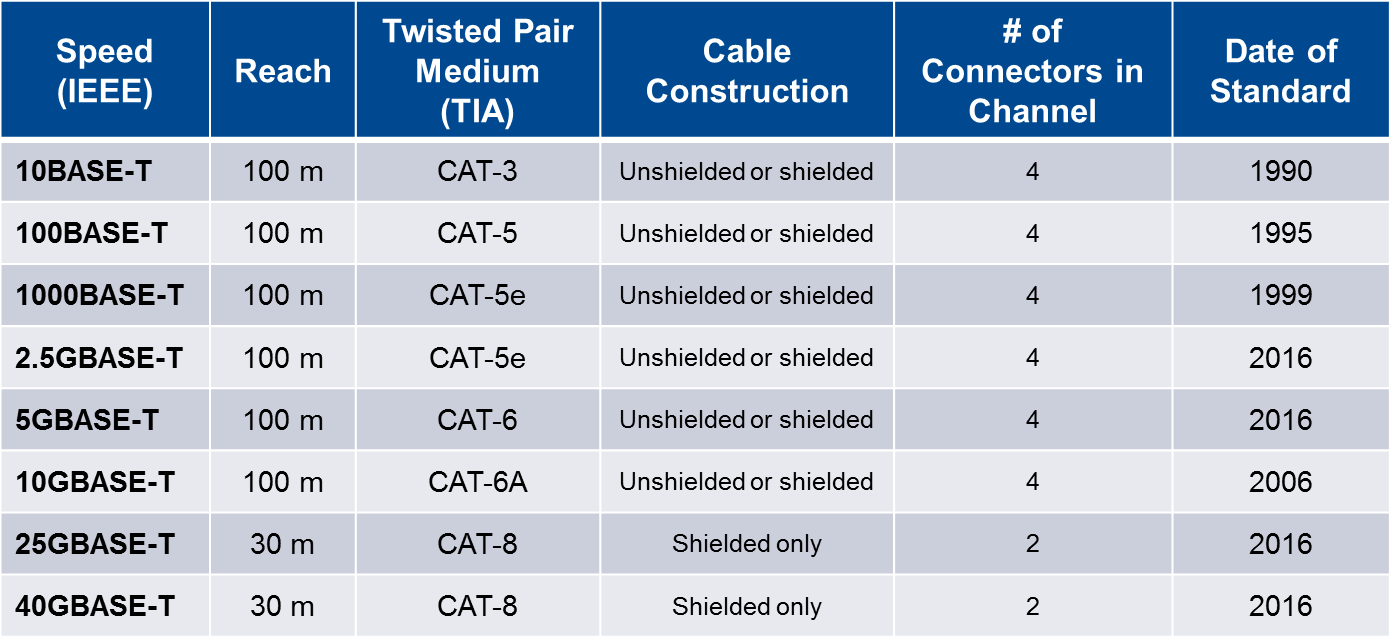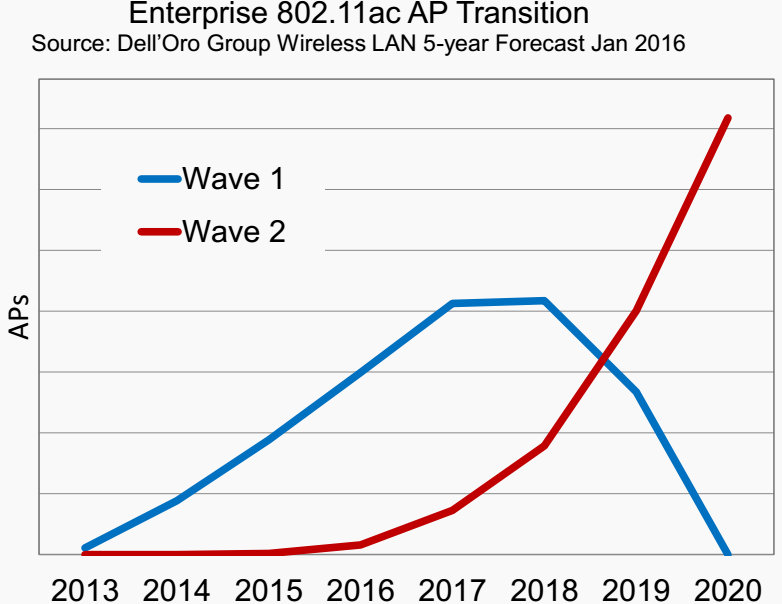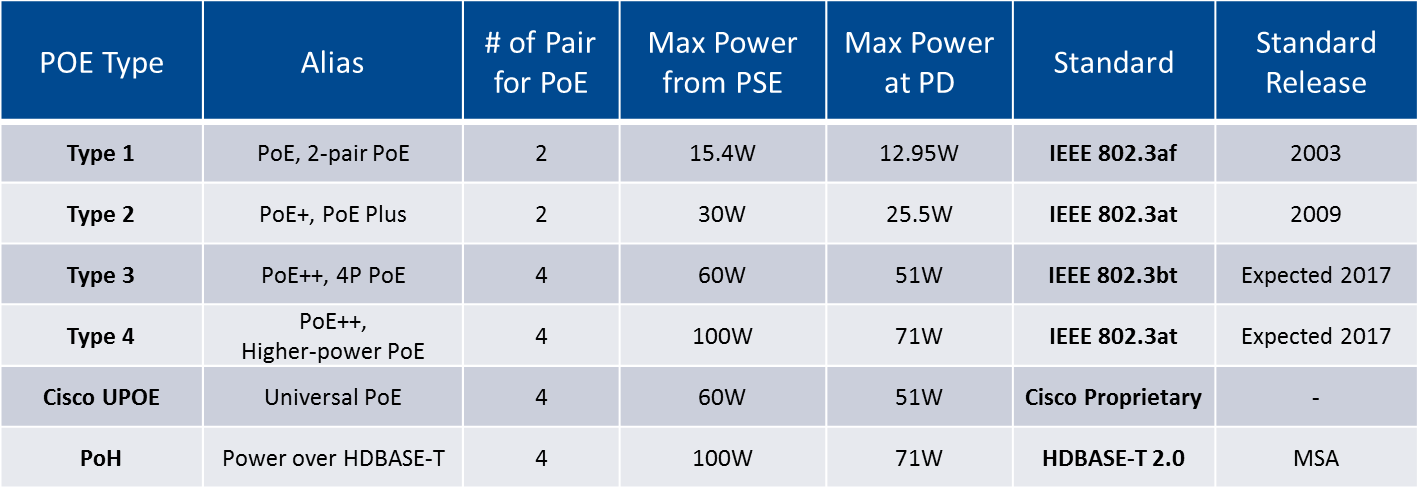Next-Generation Ethernet in Local Area Networks
Over the past 36 years, Ethernet has become the most adopted and widely deployed protocol in our global network infrastructures. Fixed Ethernet connections offer secure, fast, stable and consistent speeds, and easily support the download of large files or high levels of content streaming.
Case in point: Last year, according to Dell’Oro research, Ethernet switch shipment counts were at 484 million. High-end Ethernet router port shipment counts were at 5.9 million. What’s driving this phenomenal momentum? Broad market acceptance and the diverse list of applications that Ethernet supports.
As Ethernet network speeds continue to get faster – and they will – let’s take a look at current Ethernet LAN deployment applications and the emerging technologies referenced on the LAN roadmap. According to the Ethernet Alliance, Ethernet could have 12 speeds before 2020.
Twisted Pair and BASE-T Technology
For many years, copper twisted-pair (4-pair) cable with RJ45 connectors has been the most popular Ethernet access solution for desktop users. Since 2000, this solution has been driven by more than 100 million Ethernet network interface cards (NICs) and LAN-on-motherboard (LOM) controllers, although most of them are rarely used at their maximum throughput over 1G-capable cabling.
Thanks to their design versatility and universal compatibility, copper structured cabling systems have also been widely deployed in data center environments to support Ethernet application speeds from 1G to 10G.

Ethernet BASE-T applications and twisted pair categories
New LAN Applications
Higher-speed wireless LANs (including WLANs) and greater numbers of connected users and devices translate into greater bandwidth utilization per active Ethernet port; 2.5G/5G Ethernet will enable the higher-bandwidth traffic we need to support next-generation wireless LAN access points.
In the IEEE 802.11ac wireless standard, Wave 1 devices (with a PHY rate of up to 1.3 Gbps) can be supported by Category 6 or Category 5e twisted-pair cable with 2.5GBASE-T and 5GBASE-T technologies from NBASE-T Alliance, MGBASE-T Alliance and IEEE 802.3bz; however, there may be a length penalty to pay for using Category 6 or Category 5e cable. These cabling systems were initially designed for 1000BASE-T Gigabit Ethernet; therefore, we recommend installing a Category 6A cabling system to achieve high performance with no compromise. Many of the barriers that prevented Category 6A installation in the past have been removed, including high costs, large diameters and application interference.

Enterprise 802.11ac Wireless Access Point Transition (Source: Dell’Oro Group Wireless LAN 5-Year Forecast, January 2016)
10GBASE-T technology enables 10G Ethernet over Category 6A cable for a reach of 100m; its original target application was data center interconnects. The large number of next-generation connected devices under the new IEEE 802.11ac Wave 2 standards (with a maximum PHY data rate of 6.93 Gbps) and 802.11ax WLAN technology (with a maximum PHY data rate of 9.61 Gbps) will be main drivers for high-quality Category 6A deployment in commercial buildings and campus.
The emerging, complex, powerful 5G network will be much more demanding in its networking and cabling infrastructure requirements; Category 6A cabling has shown strong potential to support higher-bandwidth indoor access points using WiFi offloading technology.
If link distance is longer than the maximum allowed reach of 100m, or the required data rate per link is at a higher speed than 10G, multimode fiber or singlemode fiber will be a more suitable link solution (e.g. distribution switch connects to aggregation switch in the LAN).
Power over Ethernet technology allows network cables to deliver electrical power to connected devices with no interruption to data transmission over two or four twisted pairs. IEEE PoE standards provide for signaling between power sourcing equipment (PSE), which provides power on the network cable, and powered devices (PDs). For example, the same Category 6A cable can carry 10G Ethernet data and power remote devices such as wired LAN or wireless access points (WAPs), IP-enabled cameras and building automation sensors that require up to 100W of power.

Alternative LAN Technology
Passive Optical LAN (POLAN) is a new alternative to traditional LAN that supports point-to-multipoint networks; many passive optical components like splitters can be used. With a short implementation history, there is no established industrial standard for POLAN just yet.
POLAN was adapted from the passive optical networking (PON) standard to apply to indoor network architectures; it can support a longer reach of up to 20km with singlemode fiber. It makes uses of wavelength division multiplexing (WDM) technology to increase bandwidth per fiber. Passive splitters (with a splitting ratio of up to 1:32) can significantly reduce fiber count and deployment costs.
POLAN is most suitable for wired and WAP deployment in commercial buildings, campuses, hospitals, hotels and sports venues that require very high bandwidth due to the increasing density of connected devices. Current POLAN technology supports up to 10G upstream and downstream, and will support 25G-100G in future upgrades.
Need help deciding how to best deploy Ethernet in your LAN topology? Belden is here to help, with LAN solutions that reduce downtime, improve user access, help you with future planning and reduce security risks.
![System.String[]](https://assets.belden.com/transform/d88d257f-c23d-4a61-b354-d49d9932ec65/qing-xu?io=transform:fill,width:300,height:300)